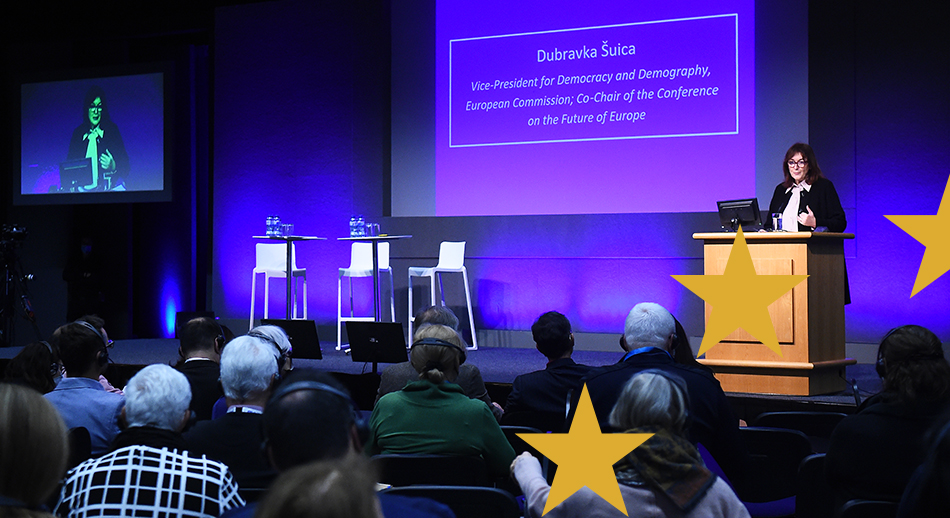The Future of Europe Conference officially ended on May 9; let’s find out together what it produced and where it could take us.
May 9: Europe Day and a “watershed” event
We have just celebrated Europe Day, which falls on May 9 in commemoration of what is considered the very first “official” building block of the European Union: the Schuman Declaration. A short and simple peace speech, a speech aimed at the goal of making war in Europe “not only unthinkable, but materially impossible.” A speech that, in its simplicity, saw itself as the very first stage of a future “European Federation” and an impulse to “change the destiny” of the peoples of Europe.
These are words that echo meaningfully even today, in a new international context that leads us to appreciate the importance and historical perspective of the European Union.
May 9 was celebrated with various initiatives in different countries of Europe and by different EU institutions. You can find out about events and activities on the theme, offered both live and online, through a page dedicated to the celebration of Europe.
We want to devote this in-depth study to a major event that marked last May 9 and that could represent a new step in the process of European construction. As we are about to find out, it was an important May 9: much more than just a “birthday” for Europe.
This May 9 marks the conclusion of a year-long debate on the future of Europe, uniting the voices and faces, ideas and aspirations of citizens in a colossal exercise in democratic participation. In the words of European Commission President Ursula von der Leyen, this is “a far more powerful image than any military parade.” An image reminiscent of “To never take for granted what Europe is and what it means. Europe is a dream. A dream that has always been. A dream born of tragedy.”
A year of debates on Europe: a great exercise in democratic participation
The Conference on the Future of Europe is a wide-ranging initiative launched more than a year ago with the aim of designing-with the participation of citizens-a Europe and EU institutions ready to respond to the challenges and needs of today’s world: we talked about it here.
Over the past year, EU institutions and all EU citizens (through adedicated platform, thematic panels, and a dedicated series of events) have discussed Europe’s present and future challenges (in their different aspects) and possible solutions to address them.
Dedicated sites provide access to documentation, photos and videos of the initiative, which is also widely presented and promoted on the pages of the main EU institutions(Parliament, Council and Commission).
TheEuropean University Institute has collected major publications on relevant issues, devoting specific content to the future of Europe and its recently concluded major annual “State of the Union” event.
Conference proposals: the contours of a new Europe?
The plenary and concluding meeting of the Future of Europe Conference was held on April 29-30. Representatives of the four institutional components of the conference (Parliament, Council, Commission and national parliaments) agreed to the recommendations contained in its final report: more than 300 measures, organized into 49 proposals and 9 thematic areas, that point the way to far-reaching reforms of the European Union. Reforms that (following the Conference co-chair’s closing remarks ) are necessary for Europe’s very survival in an increasingly complex and difficult world.
We reproduce below the pages of the four panels, the related recommendations, the pages devoted to the work in each topic, and the related notes on the actions the European Parliament intends to take. The official conclusions of the conference in the 9 thematic areas are given in its final report.
Panel 1: Recommendations 1) Economy, social justice and labor + (PE note) 2) Digital transformation + (PE note) – Education, culture, youth and sports + (PE note)
Panel 2: Recommendations 1) European Democracy + (PE note) 2) Values and rights, rule of law, security + (PE note)
Panel 3: Recommendations 1) Climate and environment + (PE note) 2) Health + (PE note)
Panel 4: Recommendations 1) The EU in the world + (PE note) 2) Migration + (PE note)
Expectations for the post-Conference: the revision of the Treaties?
The final report was presented on May 9 to the heads of the three main EU institutions (Commission, Parliament and Council): the same ones that more than a year ago, in kicking off the Conference, pledged to follow up on the resulting proposals; and that will now have to find ways to do so effectively, each within its own remit. The representatives of the three institutions (Ursula von der Leyen for the European Commission, Roberta Metsola for the European Parliament, and Emmanuel Macron for the Council of the European Union) enthusiastically welcomed the proposals and the prospect of giving new impetus to the European Union and its ability to respond to the great challenges of today’s world. In the three links above we offer the respective speeches, here a general press release and here a summary of the main information, in question-and-answer format. Part of the proposals presented will require a revision of the EU’s founding treaties. This represents one of the main points of the current debate, as the Treaties (which we discuss here) are the foundation of all community building, in a real as well as metaphorical sense. They are the basis for the functioning of the EU and the EU institutions and define their existence, role, objectives and areas of competence. Therefore, real structural changes to the way the EU and its institutions are and act may come out of the Conference. This is the sense of the action of the participants in the Conference and the report produced. This major exercise in democratic participation has raised important expectations among European citizens and public opinion. The European Parliament has already indicated (and officially confirmed) its willingness to activate the procedure provided for the revision of the Treaties.
Challenges and prospects: a summary
The path taken by the European Parliament was also immediately supported by Mario Draghi, in his first speech as Council President before the plenary meeting of the European Parliament. It is a speech that we recommend reading here in its entirety: it is a lucid, reasoned and passionate summary of the challenges we are facing and the road ahead for the institutions and citizens of the European Union. The speech is introduced by a tribute to the memory of President David Sassoli, one of the initiators of these major changes. It precisely summarizes the highlights of the major challenges facing Europe, whose multiple “humanitarian, security, energy, economic” nature requires “a decisive acceleration in the integration process.” He thus proposes a federalism that is as “pragmatic” as it is “ideal,” and draws parallels between the difficult moments in the History of Europe (postwar to the present) and the stages of the European integration process. He calls for approaching “with courage and confidence” the process of revising the Treaties and overcoming intergovernmental logic in order to build a Europe in which citizens “will be able to recognize themselves with pride.” This process will have to deal with the reluctance of some states to revise painstakingly achieved balances, especially in its more structural components, in the revision of the Treaties and on the more politically sensitive aspects, such as overcoming the right of veto of member states, in favor of qualified majority mechanisms. Already thirteen member states have expressed reservations about changing the Treaties. However, the climate that President Draghi wants to make himself the bearer of and the historical moment could favor the achievement of new, ambitious-and more necessary-than ever policy goals. The unanimous position expressed last May 9 by the EU institutions (including the Council) is certainly a positive sign.




